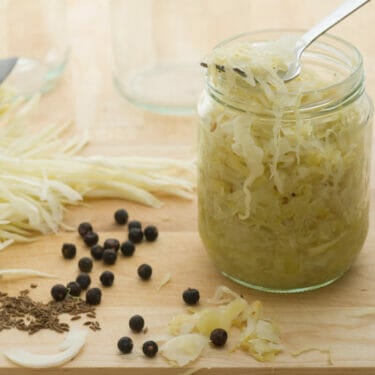
How To Make Homemade Sauerkraut in a Mason Jar
Homemade sauerkraut is a simple, old-fashioned way to preserve cabbage and create a delicious, probiotic-rich food. This easy method uses nothing more than cabbage, salt, and a mason jar—no fancy tools required.
Print Recipe
Equipment
- 1 Mason Jar quart-size
Instructions
- Wash your cabbage, weigh it, and jot down the weight for reference.1 Cabbage
- Remove and discard any damaged outer leaves. Cut out the core and set aside one clean outer leaf for later.
- Sprinkle salt over the shredded cabbage (see recipe note below) and let it rest for about 15 minutes.3-4 tsp Salt
- Massage the cabbage with clean hands for 5-10 minutes until it softens and releases its liquid to create a natural brine.
- Pack the cabbage tightly into a clean mason jar, pressing it down firmly as you go to eliminate air pockets.
- Pour any remaining liquid from the bowl into the jar, ensuring the cabbage is fully submerged under the brine.
- Cut a circle from the reserved cabbage leaf to fit the opening of the jar and place it on top of the packed cabbage to help keep it submerged.
- Place a fermenting weight on top of the cabbage leaf and make sure everything stays beneath the liquid. Secure the lid loosely.
- Store the jar at room temperature (70-75°F) for 3 to 4 weeks. Check periodically to ensure the cabbage remains submerged.
- Once fermented to your liking, remove the weight and cabbage leaf, seal the jar with a tight-fitting lid, and transfer it to the refrigerator.
Notes
If your cabbage doesn’t release enough liquid to fully cover itself, make a simple brine using 1 teaspoon of salt per cup of water and add just enough to cover.
Fermentation times may vary depending on temperature. Cooler temps will slow the process; warmer temps may speed it up. Taste after the first week and continue fermenting until you reach your desired flavor.
Nutrition
Calories: 28kcal | Carbohydrates: 7g | Protein: 1g | Fat: 0.1g | Saturated Fat: 0.04g | Polyunsaturated Fat: 0.02g | Monounsaturated Fat: 0.02g | Sodium: 1038mg | Potassium: 193mg | Fiber: 3g | Sugar: 4g | Vitamin A: 111IU | Vitamin C: 42mg | Calcium: 46mg | Iron: 1mg
Servings: 8 servings
Calories: 28kcal
Cost: $3